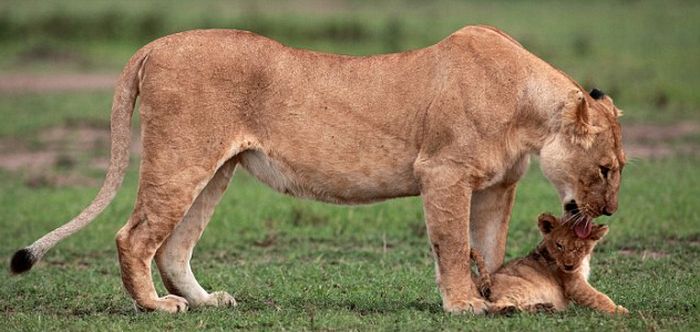|
|
Lion Cub Saved By Lioness
|
The Asiatic lion is a common motif in Chinese art. They were first used in art during the late Spring and Autumn Period (fifth or sixth century BC), and became much more popular during the Han Dynasty (206 BC – AD 220), when imperial guardian lions started to be placed in front of imperial palaces for protection. Because lions have never been native to China, early depictions were somewhat unrealistic; after the introduction of Buddhist art to China in the Tang Dynasty (after the sixth century AD), lions were usually depicted without wings, their bodies became thicker and shorter, and their manes became curly. The lion dance is a form of traditional dance in Chinese culture in which performers mimic a lion's movements in a lion costume, often with musical accompaniment from cymbals, drums and gongs. They are performed at Chinese New Year, the August Moon Festival and other celebratory occasions for good luck.
The island nation of Singapore derives its name from the Malay words singa (lion) and pora (city/fortress), which in turn is from the Tamil-Sanskrit சிங்க singa सिंह siṃha and पुर புர pura, which is cognate to the Greek πόλις, pólis. According to the Malay Annals, this name was given by a fourteenth century Sumatran Malay prince named Sang Nila Utama, who, on alighting the island after a thunderstorm, spotted an auspicious beast on shore which appeared to be a lion.
"Lion" was the nickname of several medieval warrior rulers with a reputation for bravery, such as the English King Richard the Lionheart, Henry the Lion (German: Heinrich der Löwe), Duke of Saxony and Robert III of Flanders nicknamed "The Lion of Flanders"—a major Flemish national icon up to the present. Lions are frequently depicted on coats of arms, either as a device on shields themselves, or as supporters. (The lioness is much more infrequent.) The formal language of heraldry, called blazon, employs French terms to describe the images precisely. Such descriptions specified whether lions or other creatures were "rampant" or "passant", that is whether they were rearing or crouching. The lion is used as a symbol of sporting teams, from national association football teams such as England, Scotland and Singapore to famous clubs such as the Detroit Lions of the NFL, Chelsea and Aston Villa of the English Premier League, (and the Premiership itself) to a host of smaller clubs around the world.
Lions continue to feature in modern literature, from the messianic Aslan in The Lion, the Witch and the Wardrobe and following books from The Chronicles of Narnia series written by C. S. Lewis, to the comedic Cowardly Lion in The Wonderful Wizard of Oz. The advent of moving pictures saw the continued presence of lion symbolism; one of the most iconic and widely recognised lions is Leo the Lion, which has been the mascot for Metro-Goldwyn-Mayer (MGM) studios since the 1920s. The 1960s saw the appearance of what is possibly the most famous lioness, the Kenyan animal Elsa in the movie Born Free, based on the true-life international bestselling book of the same title. The lion's role as King of the Beasts has been used in cartoons, from the 1950s manga which gave rise to the first Japanese colour TV animation series, Kimba the White Lion, Leonardo Lion of King Leonardo and his Short Subjects, both from the 1960s, up to the 1994 Disney animated feature film The Lion King, which also featured the popular song "The Lion Sleeps Tonight" in its soundtrack. A lion appears on the 50-rand South African banknote.
|
|









